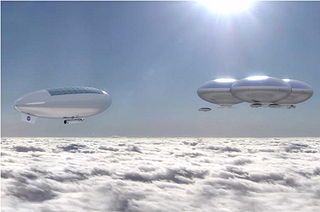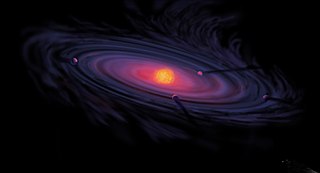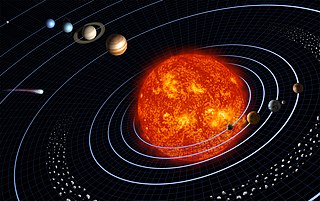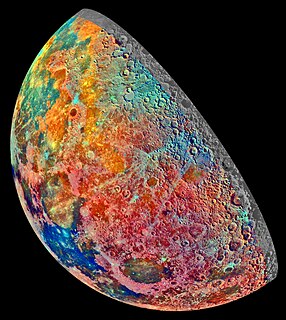
The giant planets constitute a diverse type of planet much larger than Earth. They are usually primarily composed of low-boiling-point materials (volatiles), rather than rock or other solid matter, but massive solid planets can also exist. There are four known giant planets in the Solar System: Jupiter, Saturn, Uranus and Neptune. Many extrasolar giant planets have been identified orbiting other stars.

Interplanetary spaceflight or interplanetary travel is the crewed or uncrewed travel between stars and planets, usually within a single planetary system. In practice, spaceflights of this type are confined to travel between the planets of the Solar System. Uncrewed space probes have flown to all the observed planets in the Solar System as well as to dwarf planets Pluto and Ceres, and several asteroids. Orbiters and landers return more information than fly-by missions. Crewed flights have landed on the Moon and have been planned, from time to time, for Mars and Venus. While many scientists appreciate the knowledge value that uncrewed flights provide, the value of crewed missions is more controversial. Science fiction writers propose a number of benefits, including the mining of asteroids, access to solar power, and room for colonization in the event of an Earth catastrophe.

A fusion rocket is a theoretical design for a rocket driven by fusion propulsion that could provide efficient and sustained acceleration in space without the need to carry a large fuel supply. The design requires fusion power technology beyond current capabilities, and much larger and more complex rockets.

An aerobot is an aerial robot, usually used in the context of an unmanned space probe or unmanned aerial vehicle.

An atmosphere is a layer of gas or layers of gases that envelope a planet, and is held in place by the gravity of the planetary body. A planet retains an atmosphere when the gravity is great and the temperature of the atmosphere is low. A stellar atmosphere is the outer region of a star, which includes the layers above the opaque photosphere; stars of low temperature might have outer atmospheres containing compound molecules.

Alternative fuel, known as non-conventional and advanced fuels, are any materials or substances that can be used as fuels, other than conventional fuels like; fossil fuels, as well as nuclear materials such as uranium and thorium, as well as artificial radioisotope fuels that are made in nuclear reactors.

An ice giant is a giant planet composed mainly of elements heavier than hydrogen and helium, such as oxygen, carbon, nitrogen, and sulfur. There are two ice giants in the Solar System: Uranus and Neptune.

Sudarsky's classification of gas giants for the purpose of predicting their appearance based on their temperature was outlined by David Sudarsky and colleagues in the paper Albedo and Reflection Spectra of Extrasolar Giant Planets and expanded on in Theoretical Spectra and Atmospheres of Extrasolar Giant Planets, published before any successful direct or indirect observation of an extrasolar planet atmosphere was made. It is a broad classification system with the goal of bringing some order to the likely rich variety of extrasolar gas-giant atmospheres.

The colonization of Venus has been a subject of many works of science fiction since before the dawn of spaceflight, and is still discussed from both a fictional and a scientific standpoint. However, with the discovery of Venus's extremely hostile surface environment, attention has largely shifted towards the colonization of the Moon and Mars instead, with proposals for Venus focused on habitats floating in the upper-middle atmosphere and on terraforming.

In speculative fiction, floating cities and islands are a common trope, which range from cities and islands that float on water to ones that float in the atmosphere of a planet by purported scientific technologies or by magical means. While very large floating structures have been constructed or proposed in real life, aerial cities and islands remain in the realm of fiction.

The terraforming of Venus or the terraformation of Venus is the hypothetical process of engineering the global environment of the planet Venus in such a way as to make it suitable for human habitation. Terraforming Venus was first proposed in a scholarly context by the astronomer Carl Sagan in 1961, although fictional treatments, such as The Big Rain of The Psychotechnic League by novelist Poul Anderson, preceded it. Adjustments to the existing environment of Venus to support human life would require at least three major changes to the planet's atmosphere:
- Reducing Venus's surface temperature of 737 K
- Eliminating most of the planet's dense 9.2 MPa (91 atm) carbon dioxide and sulfur dioxide atmosphere via removal or conversion to some other form
- The addition of breathable oxygen to the atmosphere.

In space exploration, in situ resource utilization (ISRU) is the practice of collection, processing, storing and use of materials found or manufactured on other astronomical objects that replace materials that would otherwise be brought from Earth.

The formation of the Solar System began about 4.6 billion years ago with the gravitational collapse of a small part of a giant molecular cloud. Most of the collapsing mass collected in the center, forming the Sun, while the rest flattened into a protoplanetary disk out of which the planets, moons, asteroids, and other small Solar System bodies formed.

The study of extraterrestrial atmospheres is an active field of research, both as an aspect of astronomy and to gain insight into Earth's atmosphere. In addition to Earth, many of the other astronomical objects in the Solar System have atmospheres. These include all the gas giants, as well as Mars, Venus and Titan. Several moons and other bodies also have atmospheres, as do comets and the Sun. There is evidence that extrasolar planets can have an atmosphere. Comparisons of these atmospheres to one another and to Earth's atmosphere broaden our basic understanding of atmospheric processes such as the greenhouse effect, aerosol and cloud physics, and atmospheric chemistry and dynamics.

A helium planet is a planet with a helium-dominated atmosphere. This contrasts with ordinary gas giants such as Jupiter and Saturn, whose atmospheres consist primarily of hydrogen, with helium as a secondary component only. Helium planets might form in a variety of ways. Gliese 436 b is a possible helium planet.

The Solar System have been considered for colonization and terraforming. The main candidates for colonization in the inner Solar System are Mars and Venus. Other possible candidates for colonization include the Moon and even Mercury.
A Propulsive Fluid Accumulator is an artificial Earth satellite which collects and stores oxygen and other atmospheric gases for in-situ refuelling of high-thrust rockets. This eliminates the need to lift oxidizer to orbit and therefore brings significant cost benefits. A major portion of the total world payload sent into low earth orbit each year is either liquid oxygen or water.

A gas giant is a giant planet composed mainly of hydrogen and helium. Gas giants are also called failed stars because they contain the same basic elements as a star. Jupiter and Saturn are the gas giants of the Solar System. The term “gas giant” was originally synonymous with “giant planet”, but in the 1990s it became known that Uranus and Neptune are really a distinct class of giant planets, being composed mainly of heavier volatile substances. For this reason, Uranus and Neptune are now often classified in the separate category of ice giants.
The following outline is provided as an overview of and topical guide to Uranus:

The Moon bears substantial natural resources which could be exploited in the future. Potential lunar resources may encompass processable materials such as volatiles and minerals, along with geologic structures such as lava tubes that together, might enable lunar habitation. The use of resources on the Moon may provide a means of reducing the cost and risk of lunar exploration and beyond.

















